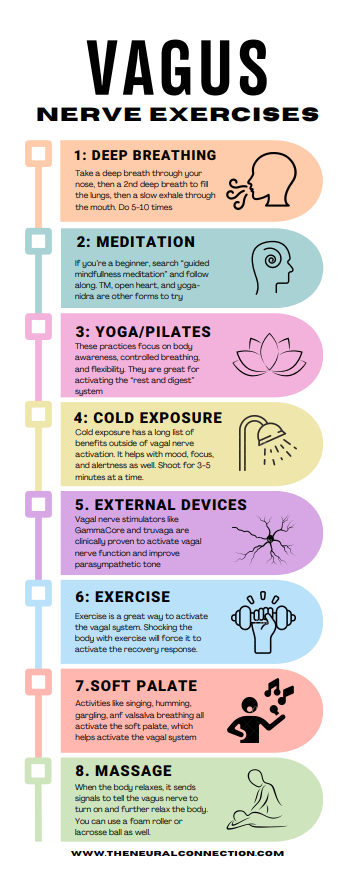Daily Vagal Nerve Exercises You’ll Love (For PDF Click Here)
Daily vagal nerve exercises can change your life. We would know from experience!
If you’ve been on a quest to enhance your well-being, you might have encountered the term “vagal nerve.” Promising relaxation, improved mood, and even better digestion, this nerve is like the unsung hero of your body. Let’s chat about daily vagal nerve exercises, which are more straightforward than you think and just might become your new favorite wellness habit! (Download the Daily Vagal Nerve Exercises PDF in the link above.)
Getting to Know Your Vagal Nerve
Before we dive into our daily vagal nerve exercises, let’s get to know our star player. The vagal nerve is part of your parasympathetic nervous system (remember the “rest and digest” crew?). It’s responsible for slowing your heart rate, relaxing muscles in the gut, and sending chill vibes throughout your body.
Picture it as your body’s own zen master, quietly working to keep things calm and collected. So, why not give it some love in return?
Our Favorite Daily Vagal Nerve Exercises
1: Deep Breathing
There are many ways to activate the vagus nerve through breathing. Diaphragmatic breathing, Valsalva breathing, box breathing, and physiologic sighs all help activate the vagus nerve. This is one of the easiest daily vagal nerve exercises to perform because it’s free and you can do it anywhere.
2: Meditation
Meditation also comes in many forms, and we’ve linked some of our favorite guided meditations. We love mindfulness, TM, and yoga-nidra for vagal nerve activation. These practices also help with emotional regulation.
3: Yoga and Pilates
These forms of exercise focus on connecting the body and mind and are a great way to jump-start the vagal system. We’ve linked a few examples for you to try.
4: Cold Exposure
Cold exposure may seem counterintuitive, but activating your recovery response is a powerful way. At first, you’ll feel a burst of alertness. Still, over time, your vagal system will activate to counteract the initial stress of the cold. It’s one of the most well-researched ways to improve vagal tone. Start with 3 minutes.
5: External Devices
The anatomy of the vagal nerve makes it easy to simulate externally. Devices like GammaCore and Truvaga provide gentle electrical stimulation directly on the nerve as it runs down the front part of the neck. This activation causes it to function more robustly, allowing for better recovery.
6: Exercise
Similar to cold exposure, this may seem counterintuitive at first. Exercise is inherently stressful on the body, and anything stressful, even good, will have a recovery response. These recovery responses are primarily governed by the vagal system, which makes exercise one of the more powerful ways to activate the vagal system.
7: Soft Palate
Anything that activates the soft palate of the throat will, in turn, co-activate the vagal system. Because each cranial nerve is close to the other, activities like gargling, humming, singing, and Valsalva breathing help activate the vagal system quickly and effectively.
8: Massage
This is unsurprising, as massages are usually relaxing (depending on the masseuse!). If you don’t have time or money to get a massage every week, you can work out tight muscles using a foam roller or lacrosse ball. Just press lightly and breathe deeply for a robust vagal nerve response.
Making Daily Vagal Nerve Exercises Part of Your Life
Incorporating these exercises into your day doesn’t have to be a chore. Pick a couple that resonate with you and sprinkle them throughout your day—during your morning routine, as a break at work, or as a relaxing bedtime ritual.
Vagal nerve exercises are not just another wellness trend; they can genuinely improve your day-to-day well-being. Giving attention to your vagus nerve helps manage stress, enhances mood, and supports your overall health in delightful and accessible ways.
Remember, the key to making a habit stick is to make it enjoyable. So smile, take a deep breath, and have fun exploring these exercises. Cheers to a happier, healthier you!
If you have questions about vagal function, click here to schedule a complimentary consultation with one of our doctors. We’ve treated hundreds of complex neurologic cases and can help you piece together the missing pieces in your recovery.
*Note: The information provided in this article is for educational purposes only and does not constitute a doctor-patient relationship. Patients should consult their medical provider or primary care physician before trying any remedies or therapies at home.

